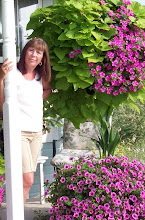 In the Victorian garden, vines were used extensively to add charm and elegance but more often to add privacy to an object, i.e., a covered gazebo or a screened porch. I love vines in today's garden because they add a certain old world ambiance in a more modern time. My favorite vine to use is the clematis.
In the Victorian garden, vines were used extensively to add charm and elegance but more often to add privacy to an object, i.e., a covered gazebo or a screened porch. I love vines in today's garden because they add a certain old world ambiance in a more modern time. My favorite vine to use is the clematis.Last spring, I planted ten different varieties of clematis, four of which I started on tall trellises (picture above) in my garden beds and two of which I started in large flower pots on my deck. These vertical elements not only add height to an uninteresting horizontal bed but also act as focal points to draw attention upward and to break up long stretches. Added to a large, free standing trellis, the vine can only grow so far upward before it loses purchase and then must begin to vine upon itself. Then we have . . . pseudo topiaries!!! Awesome.
Believe me, I have planted clematis in all the usual and ordinary places as well---around the lamp post, up a stationery arbor, at the base of the mailbox---but I wanted to use the clematis's Victorian charm in a new and modern way. I began reading about how lots of gardeners were beginning to design container gardens with perennials instead of annuals to save money. Well, a clematis is definitely a perennial and I was certainly getting tired of nurturing annual vines that by the
 end of fall were full and lush and looking super on their trellises and doomed to perish with the first hard frost. With over 250 species to choose from, I wasn't limited by color or sun/shade requirements, or watering limitations. The possibilities were endless.
end of fall were full and lush and looking super on their trellises and doomed to perish with the first hard frost. With over 250 species to choose from, I wasn't limited by color or sun/shade requirements, or watering limitations. The possibilities were endless.That's when I really dug into the research. . .
Because the clematis is so versatile, I began to look at other possible planting ideas for it. Here are just a few I think will really add zing:
1) Incorporate a clematis whose sun and water requirements are compatible with another vine like wisteria which only flowers in the very early spring. I have also matched clematis to grape vine and climbing roses. These hardy, woody vines offer extremely sturdy support for these more delicate climbers.
2) Apartment dweller and house renters can now have beautiful topiaries on their balconies and front porches without having to leave the plant behind when they move or violate lease planting restrictions.
3) Plant clematis at the base of a sturdy but nondescript tree.
4) Unsightly utility box or air conditioning unit hindering the loveliness of your yard? Choose a clematis that likes to be pruned back to nothing more than four inches of stalk sticking out of the ground. Erect a trellis, either free standing or upright, and train clematis.
The possibilities know no bounds.
I am particularly partial to Donahue's Clematis when I'm looking to purchase a new plant from my nursery. Donahue's plants are consistently healthy, vigorous growers. Every single clematis I've purchased with the Donahue's label has flowered for me the first year in the ground.
Check back later this year. I'll be posting pictures of the trellises and reporting on how each of the eight clematis are doing. Meanwhile, I'm planning to write more on specific clematis species in future postings. Look for information on clematis with great names such as the Belle of Woking, Sunset, Jackmanii, and the Dr. Ruppel just to name a few.





